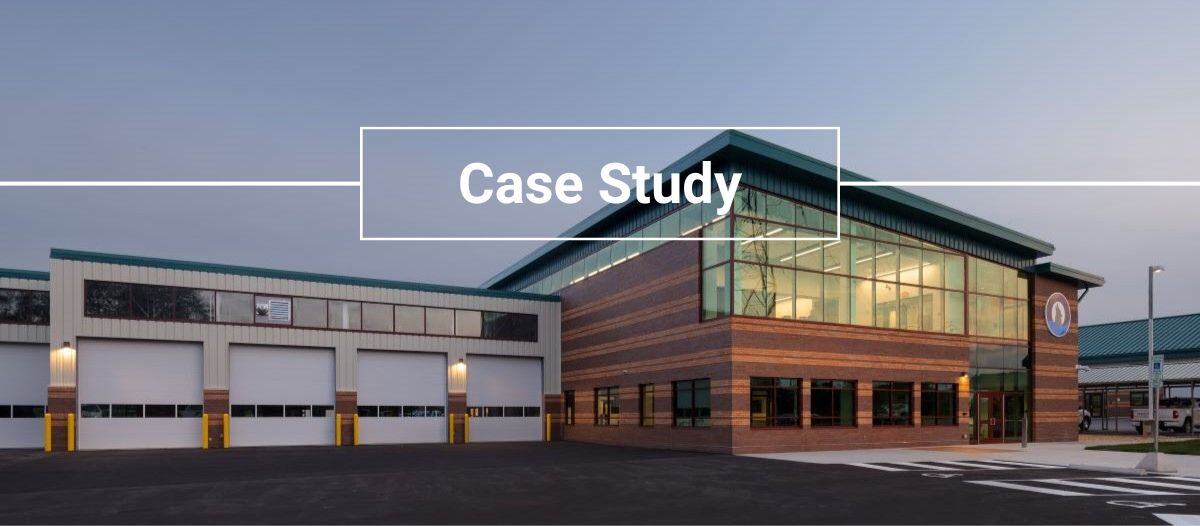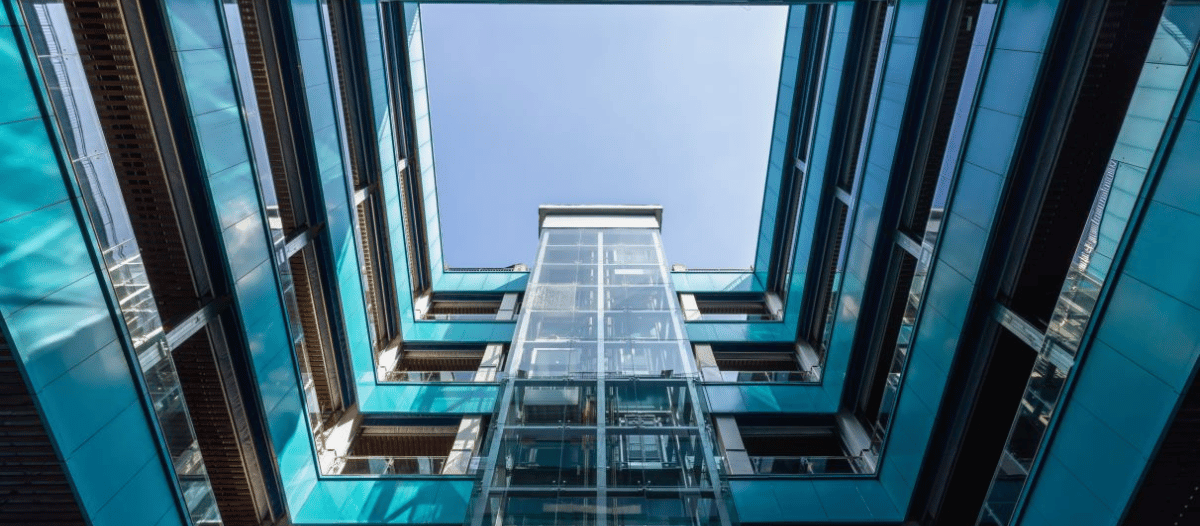Case Study: Transforming campus infrastructure to foster efficiency and community

The challenge of integrating a new facility into an existing campus often requires careful consideration and innovative design. For many campuses with a history of expansion over several decades, the result can be a sprawling landscape with a lack of cohesive layout and suboptimal functionality.
In Delaware County, Ohio, USA, these challenges and more became known during a campus renovation project for a water utility co-op. After half a century of incongruous additions to house new departments and additional staff, the public water supplier needed a comprehensive approach to renovations that would provide additional space for departments in need, a centralized hub and meeting space, and the walkability that would promote ease of interdepartmental interactions and enhance workflow efficiencies.
Campus conundrum
Originally, all the supplier’s service departments were housed in a single office building, but organic growth over many years led to the need for additional office buildings. The flow and ease of functionality were challenged as office buildings stretched onto further areas of the grounds.
As so often is the case with campus expansions, available ground space for the renovation project was limited. The project team had concerns that required renovations and expansions may not be able to be contained to the area of campus that promoted walkability and ease of interdepartmental collaboration.
To further complicate matters, there were several utility-related obstacles on the remaining land parcels that the development team needed to overcome. Overhead and in-ground power lines, gas lines, an improperly abandoned well and limited recordkeeping meant that the project team had to scrutinize existing documentation and partner with its in-house GPS department to thoroughly record and log points of all utilities. The exercise was necessary for obvious safety reasons but also would help create adequate documentation for consideration during future campus and community projects.
A master planning approach
The project team was intentional about using a master planning approach instead of adopting a single-building focus and launching into building-specific renovations. The first step in the master planning process involved analyzing the purpose and functionality of each building on the campus. The team raised key questions, such as:
- Are these buildings adequately serving the departments and staff housed within them?
- What is the useful life remaining in each of these structures?
- Which are the most critical updates that need to be prioritized?
The co-op’s project team then collaborated closely with the architecture and design team to gain an in-depth understanding of daily campus activities. Architects and designers shadowed co-op employees to observe workflow, document movement and identify opportunities for operational efficiencies. The project partners agreed that it was crucial for everyone to secure a deep understanding of the campus’ inner workings before they outlined any changes.
“From a design perspective, it was a huge help to our team to shadow the crew,” a member of the architectural firm said. “Because of that, we were able to meticulously document the entire workflow process and better understand the size of the crew and all the equipment we were dealing with.”
As a point of comparison, the architecture and design team also made site visits to nearby fire stations to see how process efficiencies like pull-through vehicle bays and building zones could be incorporated into the renovation project. They borrowed ideas from equipment bays to gear stations to clean-up stations all the way through to the break room area and offices.
The purposeful planning helped the design team eliminate back-of-house elements typically hidden from general view. Instead, the team was able to apply the look of a professional office environment in place of a typical industrial design more commonly incorporated to utility service stations.
Budgetary constraints & considerations
Budgetary constraints are the least unique aspect of any renovation or expansion project, and the cooperative water utility’s project was no exception. Post-COVID-19 residual supply chain issues, including massive price escalation and spotty materials availability, were also among the challenges the teams encountered during their project.
“We didn’t see issues across the board,” a member of the co-op’s team said. “But we were glad to have a partner that suggested affordable alternatives when we did run into issues. As long as you have a partner that isn’t suggesting outrageous substitutions, I’d encourage you to be flexible. Be open to alternatives.”
Community connection
In any project – especially one on a tight budget – it can be challenging to consider broad scope functionality in lieu of applying tunnel vision to the task at hand. But it can be helpful to consider long-term community connections along with immediate-term needs.
In the case of the Delaware County project, one pleasant surprise came in the form of community demand for a state-of-the-art training facility the teams had designed and installed in the newly renovated building. The space easily satisfied its intended purpose for optimized staff training, but it quickly evolved into a space that city and county officials, as well as community organizations, wished to use.
With the success of the space, the co-op now is considering adding ancillary services, such as event space catering. The team is also offering visitor perks, such as free access to its electric vehicle (EV) dual charger stations. In anticipating increased demand for the space, the team has incorporated additional community-friendly elements, such as a porous paving system that eventually could be converted to overflow parking space.
Designing for efficiency; achieving versatility
The renovation project in Delaware County was driven by a commitment to design a facility that optimized functionality and enhanced efficiency. As part of their project retrospective, both teams agreed that their work accomplished the primary objectives to provide additional space for departments in need, create a centralized hub and meeting space, and preserve the campus walkability that would promote ease of interdepartmental interactions and enhance workflow efficiencies.
Along the way, the team also created small, budget-friendly wins that exceeded their goals. Among those were elements such as:
- an increased use of natural light
- the addition of solar panels to garage roofs
- placement of EV charging stations that enabled the addition of electric vehicles to the water supplier’s fleet
- erection of a carport to provide additional covered parking for vehicles
“The initial analysis and assessment, when we embedded ourselves to better understand campus activity and workflow, was key to our ability to present ideas that exceeded expectations without exceeding budget,” said a representative of the architectural firm. “We were able to plan for small wins that created big differences in both functionality and community appeal.”
Retrospective and recommendations
The project is a remarkable example of how comprehensive planning and innovative design can help transform an aging campus into a focal point of community service and pride. Project leaders have these suggestions for others seeking inspiration for similar projects in which design for functionality and efficiency meets community service:
- Seek inspiration from industries, workflows and designs that parallel the project, being purposeful to consider the size of the crew, equipment and vehicles involved.
- Explore the potential to divide a building into work zones, such as vehicle bays, storage areas, post-work clean-up stations, restocking areas, locker rooms, break rooms and offices.
- Consider additional amenities that could add immediate benefit for both building occupants and community stakeholders, as well as those that could support longer-term growth.
- Evaluate options for project elements that may provide unexpected support for increased functionality or efficiencies while also adding a unique and aesthetic element to the campus.
- Explore opportunities to incorporate space for ancillary services, such as catering.
- Consider project add-ons that may become revenue generators, such as rental fees for meeting space.
- When designing a space for employees and guests, thoughtfully design points of building ingress and egress to ensure the uninterrupted flow of operations.
- When possible, prioritize sustainability without sacrificing the project’s primary goals.
- Be open to flexible, cost-effective alternatives if supply chain issues impact project plans or timelines.
- Meticulously record and map points of utility placements for ease of future development projects.

Brian Leach, FMP is the facility manager for the Del-Co Water Co., where he has worked for more than 20 years. Some of his main responsibilities are buildings, grounds and fleet management. He holds a bachelor’s degree from Ohio Wesleyan University and Water Distribution II with the Ohio EPA. Leach enjoys being responsible for maintaining Del-Co’s many assets and keeping their campuses looking great.

Zach Price is a partner at Triad Architects, where he led the design team for the Wolfe Water Center project. Price has more than two decades of architecture and design experience.
Read more on Project Management , Communication and Real Estate
Explore All FMJ Topics









